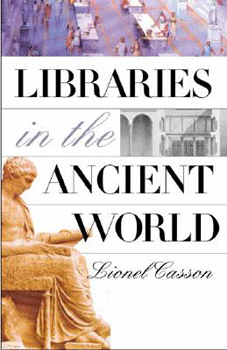Book Review
Libraries in the Ancient World
by Lionel Casson, Yale University Press (Nota Bene books), 2001
reviewed by Phoebe Ayers
This lively book looks at the founding and development of libraries in the
western world from the ancient Near East to the European Middle Ages, covering
approximately 3000 years of library history in the process. Casson, a well-known
classicist, profiles notable libraries (there is an entire chapter on the
library at Alexandria). He also chronicles the rise of libraries in everyday
life, whether as public institutions or part of a private collection. Parallel
to this, Casson tracks related developments in the various societies that
he studies, such as the book (there is a separate chapter on the development
of the codex), the library catalog (he notes the first known instance of alphabetization),
and literacy – as well as what we know about the individual librarians
involved. He describes how libraries were developed and how they fit into
each of the societies that he looks at, whether as educational institutions
in ancient Greece or as a part of bathhouses in ancient Rome.
The book is divided into compact chapters focusing on the ancient Near
East, Greece, Alexandria and the growth of libraries, the Roman empire (both
inside and outside of Rome), and the Middle Ages. The largest part of the
book is on the heyday of Greece and Rome; the Middle Ages is introduced
but not looked at with the same depth. Egyptian libraries are not examined,
because, as Casson notes, their holdings of writings on papyrus rotted away.
Much of the information that we have about ancient libraries is based by
necessity on either archeological records or obscure mentions in various
ancient histories and commentaries. However, Casson extrapolates the likely
use and policies associated with these libraries. He provides a library-centric
focus, talking about aspects that have parallels with libraries today, with
intriguing examples. For instance, he talks about accessions procedure in
the library at Alexandria (“rolls usually had a tab attached to one
end bearing the author's name and ethnic” (35)), collection development
at Rome (“War meant loot, and the opportunity to loot offered in certain
places a quick way of acquiring a library” (68)), and the borrowing
procedures in Sumeria, where the library holdings consisted of clay tablets.
From the colophon of one of these tablets comes a breathtaking damage policy
that may remain useful as a muttered incantation for the librarian whose
patrons damage books:
“
'He who breaks this tablet or puts it in water or rubs it until you
cannot recognize it [and] cannot make it be understood, may Ashur,
Sin, Shamash, Adad and Ishtar, Bel, Nergal, Ishtar of Ninevah, Istar
of Arbela, Ishtar of Bit Kidmurri, the gods of heaven and earth and
the gods of Assyria, may all these curse him with a curse which cannot
be relieved, terrible and merciless, as long as he lives, may they
let his name, his seed, be carried off from the land, may they put
his flesh in a dog's mouth!'” (14).
Throughout, Casson offers up similar gems. His writing is entertaining
and fast-paced, there are many pictures and drawings, and at only 145 pages,
the book is short enough for even overworked students to read. While Casson
does provide detailed notes on his sources, these are not included in the
text but are incorporated in an additional 26 pages at the back. There is
also an index and a list of illustrations. This is a great compilation of
information on a wonderful topic, and for library students, a fascinating
look at our predecessors.
|

"This is a great compilation of
information on a wonderful topic, and for library students, a fascinating
look at our predecessors."
.
|

